Wai-Fah Chen.The Civil Engineering Handbook
Подождите немного. Документ загружается.

34-28 The Civil Engineering Handbook, Second Edition
Freeze and Cherry (1979), provides a textbook with a detailed treatment of groundwater flow and
transport processes.
Bear(1979) and Bear and Verrujt (1987) provide an in depth study of ground water flow and contaminant
transport, respectively, from a mathematical perspective.
Other useful textbooks on groundwater flow and contaminant transport include Charbeneau (2000) and
Bedient et al.(1994).
Young et al. (1992) discuss the basic principles of contaminant transport in the unsaturated zone.
Deutsch and Journel (1992) provide a didactic review of kriging as well as a collection of geostatistical
routines and Fortran source code for PC computers.
Delleur (1999) provides an extensive handbook on practical and theoretical aspects of groundwater
engineering.
© 2003 by CRC Press LLC

© 2003 by CRC Press LLC
35
Sediment Transport
in Open Channels
35.1 Introduction
35.2 The Characteristics of Sediment
Density, Size, and Shape • Size Distribution • Fall (or Settling)
Ve l o city • Angle of Repose
35.3 Flow Characteristics and Dimensionless
Parameters; Notation
35.4 Initiation of Motion
The Shields Curve and the Critical Shear Stress • The Effect of
Slope • Summary
35.5 Flow Resistance and Stage-Discharge Predictors
Form and Grain Resistance Approach • Overall Resistance
Approach • Critical Velocity • Summary
35.6 Sediment Transport
Suspended Load Models • Bed-Load Models and Formulae •
Total Load Models • Measurement of Sediment Transport •
Expected Accuracy of Transport Formulae
35.7 Special Topics
Local Scour • Unsteady Aspects • Effects of a Nonuniform Size
Distribution • Gravel-Bed Streams
35.1 Introduction
The erosion, deposition, and transport of sediment by water arise in a variety of situations with engi-
neering implications. Erosion must be considered in the design of stable channels or the design for local
scour around bridge piers. Resuspension of possibly contaminated bottom sediments have consequences
for water quality. Deposition is often undesirable since it may hinder the operation, or shorten the
working life, of hydraulic structures or navigational channels. Sediment traps are specifically designed
to promote the deposition of suspended material to minimize their downstream impact, e.g., on cooling
water inlet works, or in water treatment plants. A large literature exists on approaches to problems
involving sediment transport; the following can only introduce the basic concepts in summary fashion.
It is oriented primarily to applications in steady uniform flows in a sand-bed channel; problems involving
flow nonuniformity, unsteadiness, and gravel-beds, are only briefly mentioned and coastal processes are
treated in the section on coastal engineering. Cohesive sediments, for which physico-chemical attractive
forces may lead to the aggregation of particles, are not considered at all. The finer fractions (clays and
silts, see Section 35.2) that are susceptible to aggregation are found more in estuarial and coastal shelf
regions rather than in streams. A recent review of problems in dealing with cohesive sediments is given
by Mehta et al. (1989 a, b).
D. A. Lyn
Purdue University

35
-2
The Civil Engineering Handbook, Second Edition
35.2 The Characteristics of Sediment
Density, Size, and Shape
The density of sediment depends on its composition. Typical sediments in alluvial water bodies consist
mainly of quartz, the specific gravity of which can be taken as
s
= 2.65. The specific weight is therefore
g
s
= 165.4 lb/ft,
3
or 26.0 kN/m.
3
In many formulae, the effective specific weight, which includes the effect
of buoyancy, is used, i.e., (
s
-
1)
g
, where
g
is the specific weight of water.
The exact shape of a sediment particle is not spherical, and so a compact specification of its geometry
or size is not feasible. Two practical measures of grain size are: (i) the
sedimentation or aerodynamic
diameter
— the diameter of the sphere of the same material with the same fall velocity,
w
s
, (see below
for definition) under the same conditions, and (ii) the
sieve diameter
— the length of a side of the square
sieve opening through which the particle will just pass. Because size determination is most often per-
formed with sieves, the available data for sediment size usually refer to the sieve diameter, which is taken
to be the geometric mean of the adjacent sieve meshes, i.e., the mesh size through which the particle has
passed, and the mesh size at which the particle is retained. The sedimentation diameter is related
empirically to the sieve diameter by means of a
shape factor
, S.F., which increases from 0 to 1 as the
particle becomes more spherical (for a well-worn sand, S.F.
ª
0.7).
Size Distribution
Naturally occurring sediment samples exhibit a range of grain diameters. A characteristic diameter,
d
a
,
may be defined in terms of the percent,
a
, by weight of the sample that is smaller than
d
a
. Thus, for a
sample with
d
84
= 0.35 mm, 84% by weight of the sample is less than 0.35 mm in diameter. The
median
size is denoted as
d
50
. Frequently, the grain size distribution is assumed to be
lognormally
distributed,
and a geometric mean diameter and standard deviation are defined as
d
g
= , and
s
g
= .
For a lognormal distribution,
d
50
=
d
g
, and the arithmetic mean diameter,
d
m
=
d
g
e
0.5ln(2
s
g
)
. Similarly,
d
a
can be determined from
d
g
and
s
g
from the relation,
d
a
=
d
g
s
g
Z
a
, where
Z
a
is the standard normal variate
corresponding to the value of
a
. For example, if
a
= 65%,
d
g
= 0.35 mm, and
s
g
= 1.7, then
Z
a
= 0.39,
and so
d
65
= (0.35 mm)(1.7)
0.39
= 0.43 mm. In natural sand-bed streams,
s
g
typically ranges between
1.4 and 2, but in gravel-bed streams, it may attain values greater than 4. Qualitative discussions of
sediment size may be based on a standard sediment grade scale terminology established by the American
Geophysical Union. A simplified grade scale divides the size range into cobbles and boulders (d > 64 mm),
gravels (2 mm < d < 64 mm), sands (0.06 mm < d < 2 mm), silts (0.004 mm < d < 0.06 mm), and clays
(d < 0.004 mm).
Fall (or Settling) Velocity
The
terminal velocity
of a particle falling alone through a stagnant fluid of infinite extent is called its fall
or settling velocity,
w
s
. The standard drag curve for a spherical particle provides a relationship between
d
and
w
s
(see chapter on Fundamentals of Hydraulics). For non-spherical sand particles
in water
, the fall
velocity at various temperatures can be determined from Fig. 35.1 if the sieve diameter and S.F. are known
or can be assumed (note the different fall velocity scales). As an example, for a geometric sieve diameter
of 0.3 mm and a shape factor, S.F. = 0.7, the fall velocity in water at 10
∞
C is determined as
ª
3.6 cm/s.
In a horizontally flowing turbulent suspension, the actual mean fall velocity of a given particle may be
influenced by neighboring particles (hindered settling) and by turbulent fluctuations.
Angle of Repose
The
angle of repose
of a sediment particle is important in describing the initiation of its motion and
hence sediment erosion of an inclined surface, such as a stream bank. It is defined as the angle,
q
, at
which the particle is just in equilibrium with respect to sliding due to gravitational forces. It will vary
d
16
d
84
d
84
d
16
§
© 2003 by CRC Press LLC
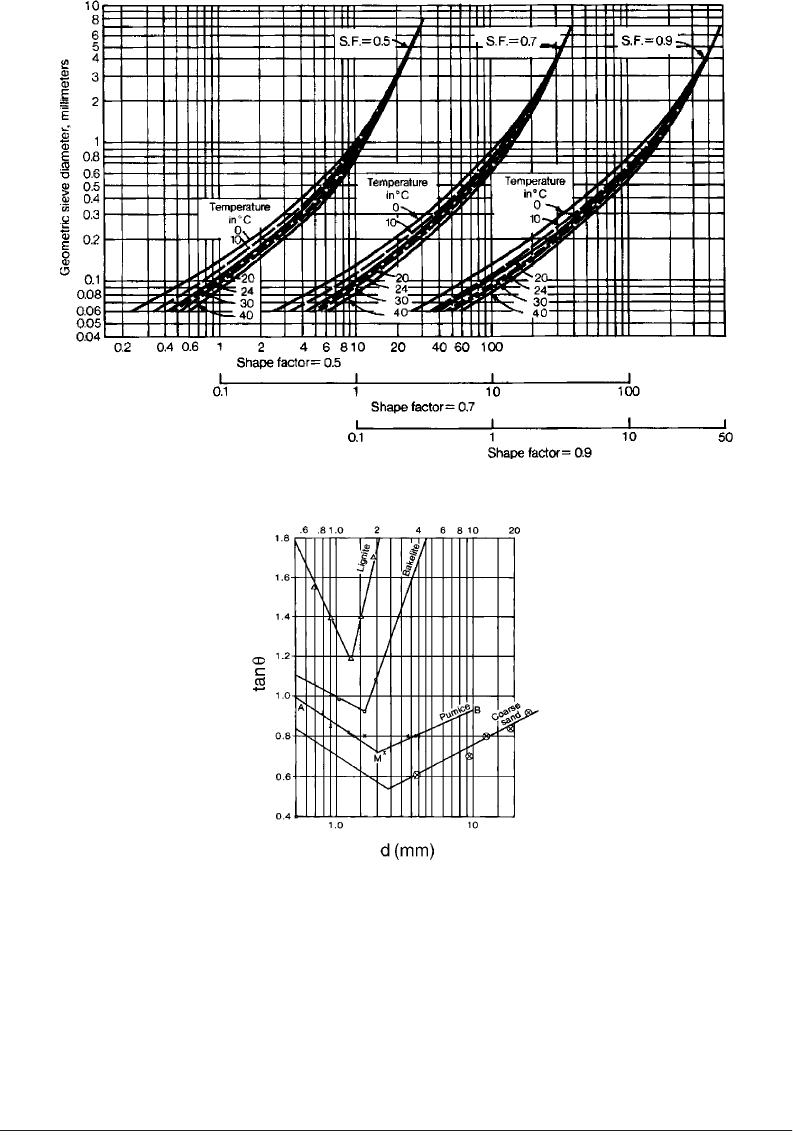
Sediment Transport in Open Channels
35
-3
with particle size, shape, and density, and empirical curves for some of these variations are given in
Fig. 35.2. The angle of repose for riprap, large stones or rock in layer(s) often used for stabilization of
erodible banks, was given in simpler form (Fig. 35.3) by Anderson (1973) as part of a procedure for the
design of channel linings. A value of 40° for the angle of repose is sometimes suggested as a design value
for riprap.
35.3 Flow Characteristics and Dimensionless
Parameters; Notation
The important flow characteristics are those associated with open-channel or more generally free-surface
flows (see the chapters on Open Channel Hydraulics or the Fundamentals of Hydraulics for more details).
These are the total water discharge,
Q
(or for wide or rectangular channels, the discharge per unit width,
FIGURE 35.1
Relationship between fall velocity, sand-grain diameter, and shape factor (taken from Vanoni, 1975).
FIGURE 35.2
Angle of repose as a function of size and shape (adapted from Simon and Sentürk, 1992).
© 2003 by CRC Press LLC
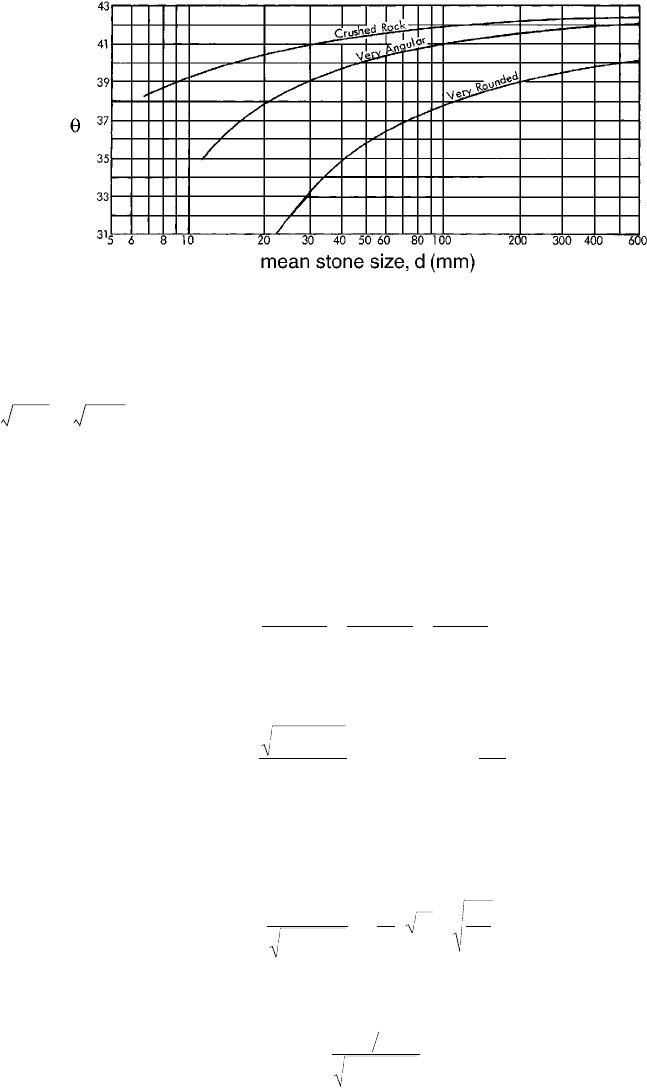
35
-4
The Civil Engineering Handbook, Second Edition
q
=
Q
/
B
, where
B
is the width of the channel), the mean velocity,
V
=
Q
/
A
, where
A
is the channel cross-
sectional area, the hydraulic radius,
R
h
, (or for a very wide channel the flow depth,
R
h
ª H), and the
energy or friction slope, S
f
. The total bed shear stress, t
b
, and the related quantities, the shear velocity,
u
*
= = , where g is the gravitational acceleration, and friction factor, f = 8(u
*
/V)
2
, are also
important.
Much of sediment transport engineering remains highly empirical, and so the organization of infor-
mation in terms of dimensionless parameters becomes important (see the discussion of dimensional
analysis in the chapter on Fundamentals of Hydraulics). Sediment and flow quantities may be combined
in several dimensionless parameters that arise repeatedly in sediment transport. A dimensionless bed
shear stress, also termed the Shields parameter (see Section 35.4), can be defined as
(35.1)
Two grain Reynolds numbers based on the grain diameter can be usefully defined as
(35.2)
where n is the fluid kinematic viscosity. Since Re
2
g
µ d
3
, a definition of a dimensionless diameter may be
motivated as d
*
= Re
g
2/3
.
A grain ‘Froude’ number also based on grain diameter can be defined as
(35.3)
A dimensionless sediment discharge per unit width, F, may be defined as:
(35.4)
where g
s
= gqC
—
is the weight flux of sediment per unit width and
—
C is the flux-weighted mass or weight
concentration of sediment (see Section 35.6 for more details).
In the above definitions, various characteristic grain diameters and shear velocities may be used
according to the context.
FIGURE 35.3 Angle of repose for riprap (from Anderson, 1973).
t
b
r§ gR
h
S
f
Q ∫
-
()
=
-
()
=
-
()
t
g
b
hf
sd
u
gs d
RS
sd111
2
*
Re Re
*
*
g
gs d
ud
∫
-
()
∫
1
3
nn
and
Fr
V
gs d
V
uf
g
∫
-
()
=
Ê
Ë
Á
ˆ
¯
˜
=
1
8
*
Q
Q
F ∫
-
()
g
gs d
ss
g
1
3
© 2003 by CRC Press LLC
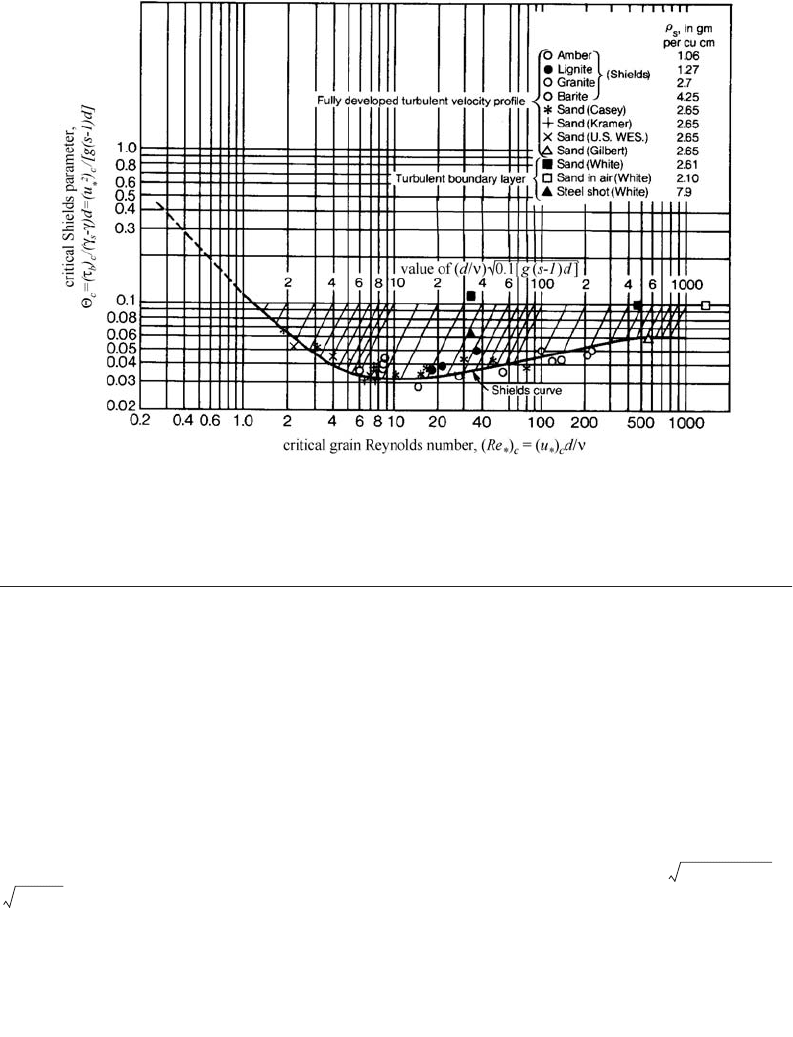
Sediment Transport in Open Channels 35-5
35.4 Initiation of Motion
The Shields Curve and the Critical Shear Stress
A knowledge of the hydraulic conditions under which the transport of sediment in an alluvial channel
begins or is initiated is important in numerous applications, such as the design of stable channels, i.e.,
channels that will not suffer from erosion, or bank stabilization, or remedial measures for scour. A
criterion for the initiation of general sediment transport in a turbulent channel flow may be given in
terms of a critical bed shear stress, (t
b
)
c
= r(u
*
)
2
c
,above which general motion of bed sediment of mean
diameter, d, is observed. The Shields curve (Fig. 35.4) correlates a critical dimensionless bed shear stress,
Q
c
, to a critical grain Reynolds number, (Re
*
)
c
, where (u
*
)
c
is used in defining both Q
c
and (Re
*
)
c
. The
Shields curve is an implicit relation, and so a solution for (u
*
)
c
must be obtained iteratively. For large
(Re
*
)
c
(i.e., for coarse sediment), Q
c
Æ ª0.06, which provides a convenient initial guess for iteration. Also
drawn on Fig. 35.4 are straight oblique lines along which an auxiliary parameter, (d/n) =
is constant. This parameter does not involve (u
*
)
c
, and so, provided d and n are known, (u
*
)
c
can be directly determined by the intersection of these lines with the Shields curve. Various formulae or
curve-fits have been proposed for describing the Shields curve; one example is due to Brownlie (1981)
and involves the auxiliary parameter, Y ∫ Re
g
–0.6
,
(35.5)
Example 35.1
Given a sand (s = 2.65) grain with d = 0.4 mm in water with n = 0.01 cm
2
/s, what is the critical shear stress?
The iterative procedure based on the graphical Shields curve starts with an initial guess, Q
c
= 0.06, implying
(u
*
2
)
c
= 2.0 cm
2
/s
2
and (Re
*
)
c
= 7.9. This is inconsistent with the Shields curve, which indicates Q
c
= 0.032
for (Re
*
)
c
= 7.9. The procedure is iterated by making another guess, Q
c
= 0.032, which yields (t
b
)
c
= 0.21
kPa corresponding to (Re
*
)
c
= 5.8. This result is sufficiently consistent with the Shield curve, and so the
FIGURE 35.4 The Shields diagram relating critical shear stress to hydraulic and particle characteristics (adapted
from ASCE Sedimentation Engineering, 1975).
0.1gs 1–()d
0.1Re
g
Q
c
Y
Y=+¥
-
022 006 10
77
..
.
© 2003 by CRC Press LLC

35-6 The Civil Engineering Handbook, Second Edition
iteration can be stopped. More directly, the auxiliary parameter, (d/n) = 10, can be computed,
and the line corresponding to this value intersects the Shields curve at Q
c
= 0.034. The use of the Brownlie
empirical formula (Eq. [35.5]) gives, with Re
g
= 32.2 and Y = 0.125, more directly Q
c
= 0.034.
Instead of using (t
b
)
c
, traditional procedures for the design of stable channels have often been formu-
lated in terms of a critical average velocity, V
c
, or critical unit-width discharge, q
c
, above which sediment
transport begins, because these quantities are more easily available than the bed shear stress. If a rela-
tionship between V and t
b
, namely a friction or flow resistance law, then V
c
can be derived from (t
b
)
c
,
and this is discussed in Section 35.5.
The Effect of Slope
The above criterion is applicable to grains on a surface with negligible slope, as is usually the case for
grains on the channel bed. Where the slope of the surface on which grains are located is appreciable,
e.g., on a river bank, its effect cannot be neglected. With the inclusion of the additional gravitational
forces, a force balance reveals that (t
b
)
c
is reduced by a fraction involving the angle of repose of the grain,
and the ratio of the value of (t
b
)
c
including slope effects to its value for a horizontal surface is given by:
(35.6)
where f = the angle of the sloping surface
q = the angle of repose of the grain.
On a horizontal surface, f = 0, and the ratio is unity, whereas if f = q, then no shear is required to
initiate sediment motion (consistent with the definition of the angle of repose).
Summary
Although the Shields curve is widely accepted as a reference, controversy remains concerning its details
and interpretation, e.g., its behavior for small (Re
*
)
c
(Raudkivi, 1990) and the effect of fluid temperature
(Taylor and Vanoni, 1972). The random nature of turbulent flow and random magnitudes of the instan-
taneous bed shear stresses motivate a probabilistic approach to the initiation of sediment motion. The
critical shear stress given by the Shields curve can be accordingly interpreted as being associated with a
probability that sediment particle of given size will begin to move. It should not be interpreted as a
criterion for zero sediment transport, and design relations for zero transport, if based on the Shields
curve, should include a significant factor of safety (Vanoni, 1975).
35.5 Flow Resistance and Stage-Discharge Predictors
The stage-discharge relationship or rating curve for a channel relating the uniform-flow water level (stage)
or hydraulic radius, R
h
, to the discharge, Q, is determined by channel flow resistance. For flow conditions
above the threshold of motion, the erodible sand bed is continually subject to scour and deposition, so
that the bed acts as a deformable or ‘movable’ free surface. The plane bed, i.e., one in which large-scale
features are absent, is often unstable, and bedforms (Fig. 35.5) such as dunes, ripples, and antidunes,
develop. Dunes, which exhibit a mild upstream slope and a sharper downstream slope, are the most
commonly occurring of bedforms in sand-bed channels. Ripples share the same shape as dunes, but are
smaller in dimensions. They may be found in combination with dunes, but are generally thought to be
unimportant except in streams at small depths and low velocities. Antidunes assume a smoother more
symmetric sinusoidal shape, which results in less flow resistance, and are associated with steeper streams.
Antidunes differ from dunes in moving upstream rather than downstream, and in being associated with
water surface variations that are in phase rather than out of phase with bed surface variations.
0.1gs 1–()d
K
slope
b
c
slope
b
c
zero slope
=
()
[]
()
[]
=-
Ê
Ë
Á
ˆ
¯
˜
t
t
f
q
1
2
2
12
sin
sin
/
© 2003 by CRC Press LLC
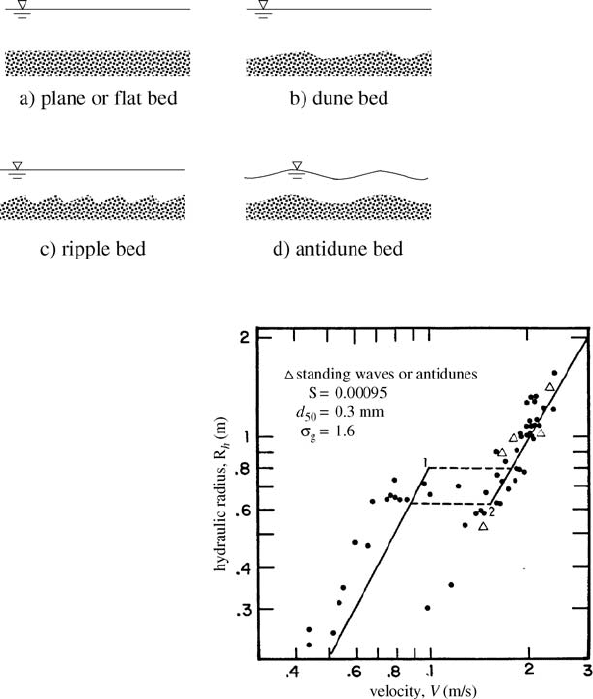
Sediment Transport in Open Channels 35-7
In fixed-bed open-channel flows, resistance
is characterized by a Darcy-Weisbach friction
factor, f (see chapter on Fundamentals of
Hydraulics) or a Manning’s n (see chapter on
Open Channel Hydraulics), which is assumed
to vary only slowly or not at all with discharge.
For movable or erodible beds, substantial
changes in flow resistance may occur as the
bedforms develop or are washed out. Very
loosely, as transport intensity (as measured,
e.g., by the Shields parameter, Q) increases, rip-
ples evolve into dunes, which in turn become
plane or transition beds, to be followed by anti-
dunes. Multiple depths may be consistent with
the same discharge or velocity (Fig. 35.6), and
the rating curve (the relationship between stage
or depth and discharge or velocity) may exhibit
discontinuities. These discontinuities are
attributed to a short-term transition from low-
velocity high-resistance flow over ripples and
dunes, termed lower-regime flow, to high-velocity low-resistance flow over plane, transition or antidune
bed, termed upper-regime flow or vice-versa. Because of these two possible regimes, movable-bed friction
formulae (unlike fixed-bed friction formulae) must include a method to determine the flow regime.
Form and Grain Resistance Approach
In flows over dunes and ripples, form resistance due to flow separation from dune tops provides the
dominant contribution to overall resistance. Yet the processes involved in determining bedform charac-
teristics are more directly related to the actual bed shear stress (as in the problem of initiation of motion).
Much of sediment transport modeling has distinguished between form and grain (skin) resistance (see
the section on hydrodynamic forces in the chapter on Fundamentals of Hydraulics for the distinction
between the two types of flow resistance). An overall bed shear stress, (t
b
)
overall
∫ g R
j
S
f
, is taken as the
sum of a contribution due to grain resistance, t¢, and a contribution due to form resistance, t≤. Since
(t
b
)
overall
is usually correlated empirically with t¢, it remains only to determine t¢ from given hydraulic
parameters. The traditional approach estimates t¢ from fixed-bed friction formulae for plane beds. A
simple effective example of this approach to stage-discharge prediction is due to Engelund and Hansen
(1967) (with extension by Brownlie (1983)) and correlates a total overall dimensionless shear stress, Q,
with a dimensionless grain shear stress, Q¢:
FIGURE 35.5 Various bedforms.
FIGURE 35.6 Stage-discharge data reported by Dawdy
(1961) for the Rio Grande River near Bernalillo, New Mexico.
(Adapted from Brownlie, 1981.)
© 2003 by CRC Press LLC

35-8 The Civil Engineering Handbook, Second Edition
Engelund-Hansen formula
(35.7a)
(35.7b)
(35.7c)
where Q¢(∫ R
h
¢S
f
/(s-1) d
50
) is related to V by a friction formula for a plane fixed bed:
(35.8)
The lower regime corresponds to flows over dune-covered beds with dominant contribution due to
form resistance, such that Q > Q¢ for values of Q¢ not too close to 0.06, whereas in the transition or
upper regime, corresponding to plane beds or beds with antidunes, Q = Q¢, because flow resistance is
expected to be due primarily to grain resistance, comparable in this respect to plane beds. The Engelund-
Hansen formula was originally developed based on large-flume laboratory data with d
50
in the range 0.19
mm to 0.93 mm, and s
g
of 1.3 for the finest sediment and 1.6 for the others.
Overall Resistance Approach
The distinction between grain (skin) and form resistance is physically sound, but the use of a plane fixed-
bed friction formula such as Eq. (35.8) cannot be justified rigorously for beds with dunes and ripples, and
the need for a further correlation between Q and Q¢ is inconvenient. A simpler more direct approach relating
Q (or R
h
) directly to Q or other dimensionless parameters may therefore be more attractive from an engi-
neering point of view. Guided by dimensional analysis, Brownlie (1983) performed regression analyses on a
large data set of laboratory and field measurements, and proposed the following stage-discharge formulae:
Brownlie formulae
(35.9a)
(35.9b)
where s
g
= the geometric standard deviation
Fr
g
= the grain Froude number (Eq. [35.3])
To determine whether the flow is in lower or upper regime, the following criteria are applied:
•for S
f
> 0.006, only upper regime flow is observed,
•for S
f
< 0.006, additional criteria are formulated in terms of a modified grain Froude number,
Fr
*
g
∫ Fr
g
/[1.74S
f
–1/3
], and a modified grain Reynolds number, D ∫ u
¢
*
d
50
/(11.6n), where u
¢
*
is the
shear velocity corresponding to the upper regime flow, i.e., due primarily to grain resistance.
• the lower limit of the upper regime is given as
(35.10a)
(35.10b)
QQ Q=
¢
-£
¢
£
()
158 006 006 055.., . . , lower regime
, . , =
¢
£
¢
£
()
QQ0551upper regime
. .
.
.
=
¢
()
-
[]
£
¢
()
-
1 425 0 425 1
18
18
QQupper regime
V
gR S
R
d
hf
h
¢
=
¢
576
551
10
65
. log
.
R
d
sFrS
h
gf g
50
095
189 074 03
0 0576 1=-
()
-
.,
.
...
s lower regime,
. ,
.
...
=-
()
-
0 0348 1
083
167 077 021
sFrS
gf g
s upper regime,
log . . log . log ,
*
10 10 10
2
0 0247 0 152 0 838 2Fr
g
up
()
=- + +
()
<DDD
= ≥log . ,
10
125 2D
© 2003 by CRC Press LLC
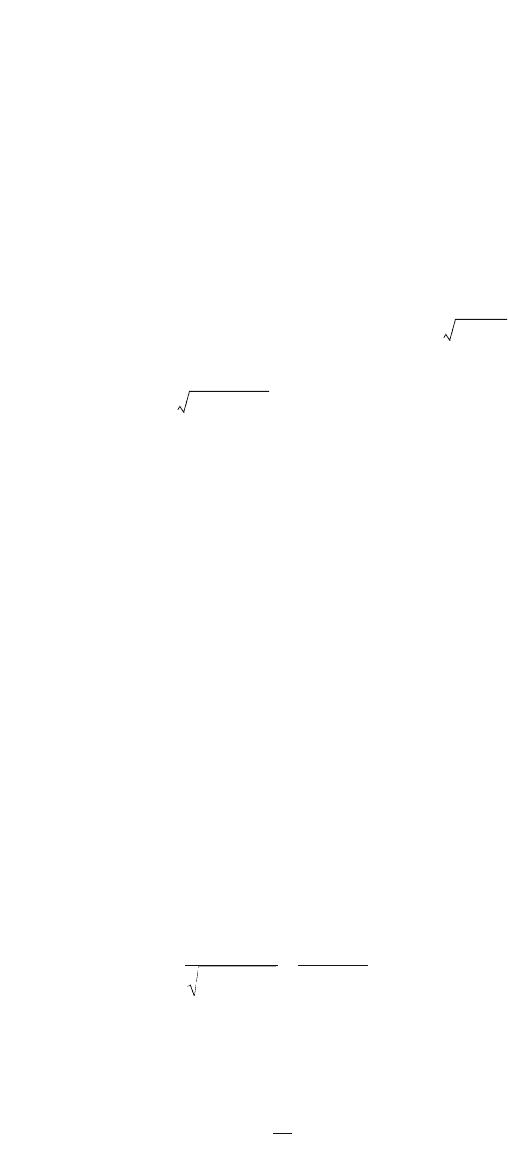
Sediment Transport in Open Channels 35-9
• the upper limit of the lower regime is given as
(35.11a)
(35.11b)
•The range of conditions covered by the data set was: 3 ¥ 10
–6
< S
f
< 3.7 x10
–2
, 0.088 mm < d
50
<
2.8mm, 0.012 m
3
/s/m < q < 40 m
3
/s/m, 0.025 < R
h
< 17 m, and temperatures between 0
∞
C and 63
∞
C.
Example 35.2
Given a wide alluvial channel with unit width discharge, q = 1.6 m
3
/s/m, and bed slope, S
0
= 0.00025,
and sand characteristics, d
50
= 0.35 mm, s
g
= 1.7, estimate the normal flow depth. The approximation
is made that, for a wide channel, R
h
ª H and V = q/H, where H is the required flow depth. With the
Brownlie formulae, substitution of the given values yields for the lower regime (Eq. [35.9a]), H
low
=
1.80 m, and for the upper regime (Eq. [35.9b]), H
up
= 1.30 m. Only one of these is the appropriate flow;
to determine which, the criteria for the two regimes are examined. Since u¢
*
= = 0.056 m/s, D =
u¢
*
d
50
/11.6n = 1.70 assuming n = 10
–6
m
2
/s. From Eqs. (35.10) to (35.11), the limits of the flow regimes
for D = 1.70 are determined as: for the upper regime, (Fr
*
g
)
up
= 1.13, and for the lower regime, (Fr
*
g
)
low
=
0.73. The parameter, Fr
*
g
= (q/H)[1.74S
f
–1/3
] is evaluated using H = H
up
to be Fr
*
g
= 0.59 <
(Fr
*
g
)= 1.13, i.e., below the lower limit of the upper flow regime, and using H = H
low
to be Fr
*
g
= 0.59 <
(Fr
*
g
)
low
= 0.73, i.e., below the upper limit of the lower flow regime. The only consistent solution for H
is therefore H
low
, and hence, according to the Brownlie criteria, the flow must then be in the lower regime,
and so the normal flow depth is estimated as H = H
low
= 1.80 m. In some (hopefully infrequent) cases,
these criteria may still not be sufficient to give a unique solution.
The Engelund-Hansen procedure involves two unknowns, H as well as H¢ (the ‘fictitious’ depth related
to grain resistance), which must be solved with the two available equations, namely, the flow resistance
relationships (Eqs. [35.7] and [35.8]), together with the requirement that q = VH. The solution for H
can be obtained with software tools, such as a spreadsheet simultaneous equation solver, or by the
following ‘manual’ iterative procedure. H¢ is initially guessed, e.g., 1 m, from which Q¢ = 0.43. According
to Eq. (35.7), this falls in the lower regime, and from Eq. (35.7a), Q = 0.96, so that H = 2.22 m. From
Eq. (35.8), the mean velocity is computed (assuming a lognormal size distribution, d
65
ª 0.43 mm for
s
g
= 1.7, see Section 35.2) as V = 1.17 m/s, and hence q = V H = 2.60 m
2
/s. Since this is not consistent
with the given q = 1.6 m
2
/s, the iteration is continued. A final iteration yields Q = 0.76 and H = 1.75 m,
which agrees well with the result using the Brownlie formulae.
Critical Velocity
Given a stage-discharge predictor, a formula for the critical velocity, V
c
, (see section 35.4 for definition)
can be obtained. For example, the Brownlie lower regime equation (Eq. [35.9a]) can be expressed in
terms of a critical grain Froude number, (Fr
g
)
c
as
(35.12)
where Q
c
is obtained from the Shields curve (e.g., Eq. [35.5]).
Based on experiments, Neill (1967) gave a simpler design formula intended for zero transport of coarse
particles,
(35.13)
log . . log . log , ,
*
10 10 10
2
0 203 0 0703 0 933 2Fr
g
low
()
=- + +
()
<DDD
= ≥log . , .
10
08 2D
gH
up
S
0
gs 1–()d
50
Fr
V
gs d
S
g
c
cc
fg
()
∫
-
()
=
1
460
50
053
014 016
.
.
..
Q
s
Fr
H
d
g
c
()
=
Ê
Ë
Á
ˆ
¯
˜
2
02
25.
.
© 2003 by CRC Press LLC
